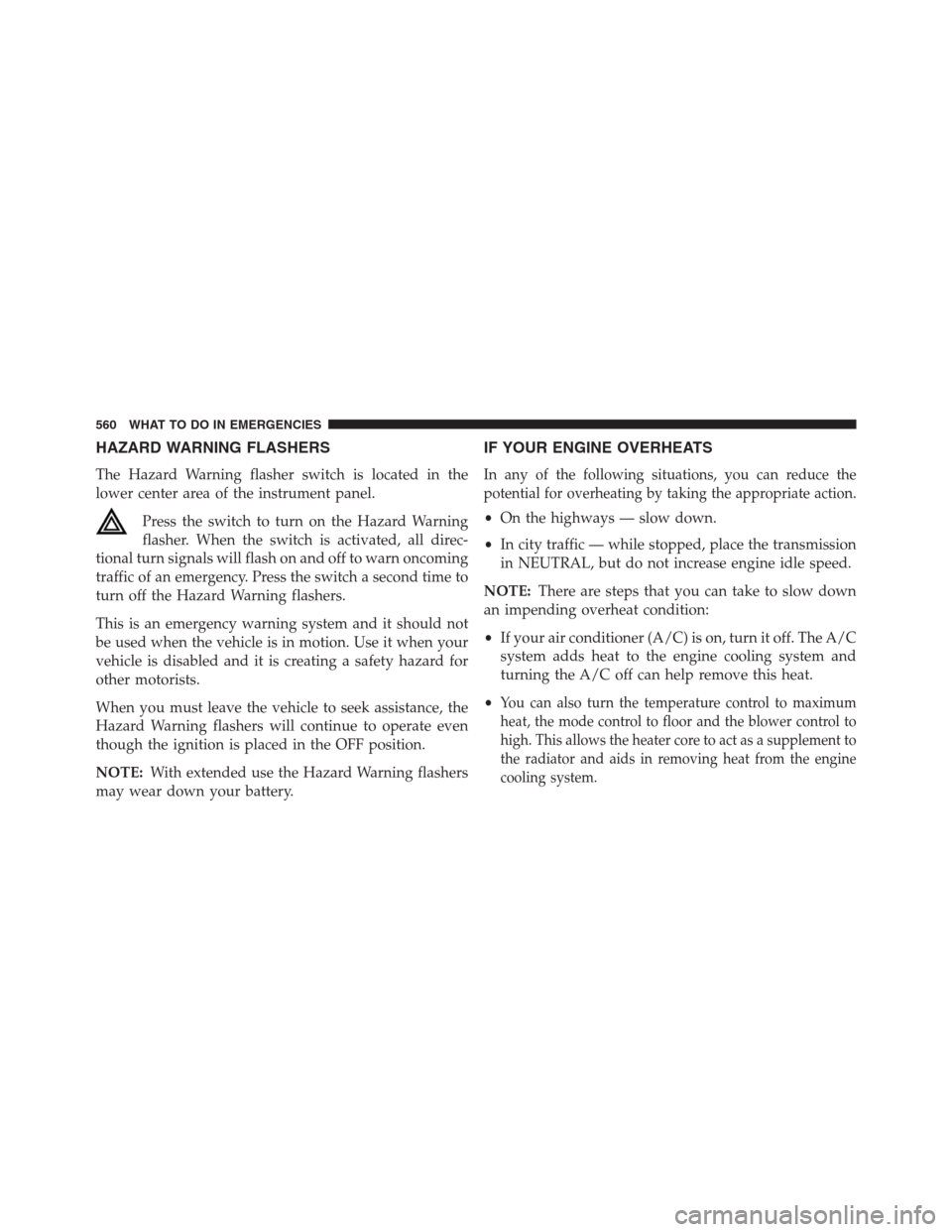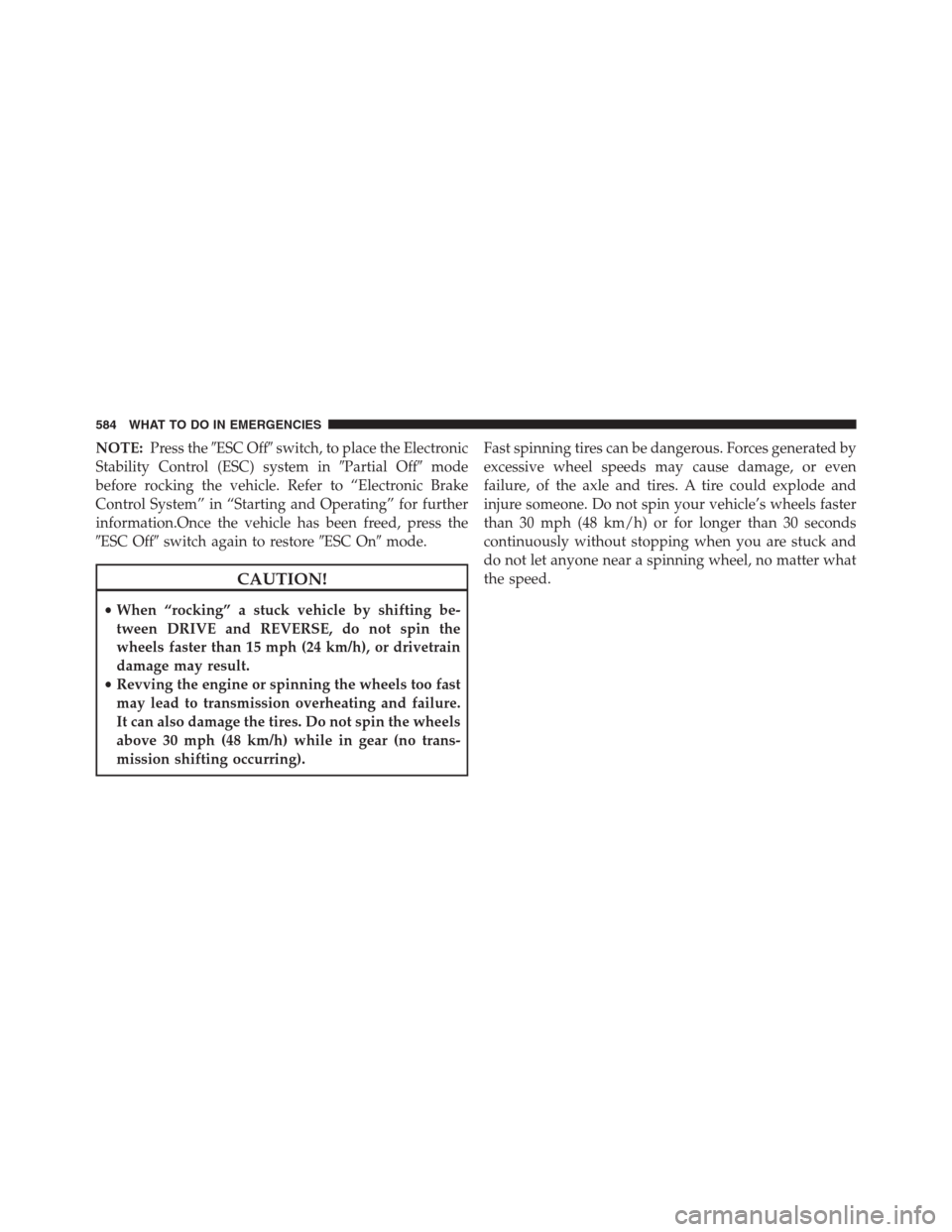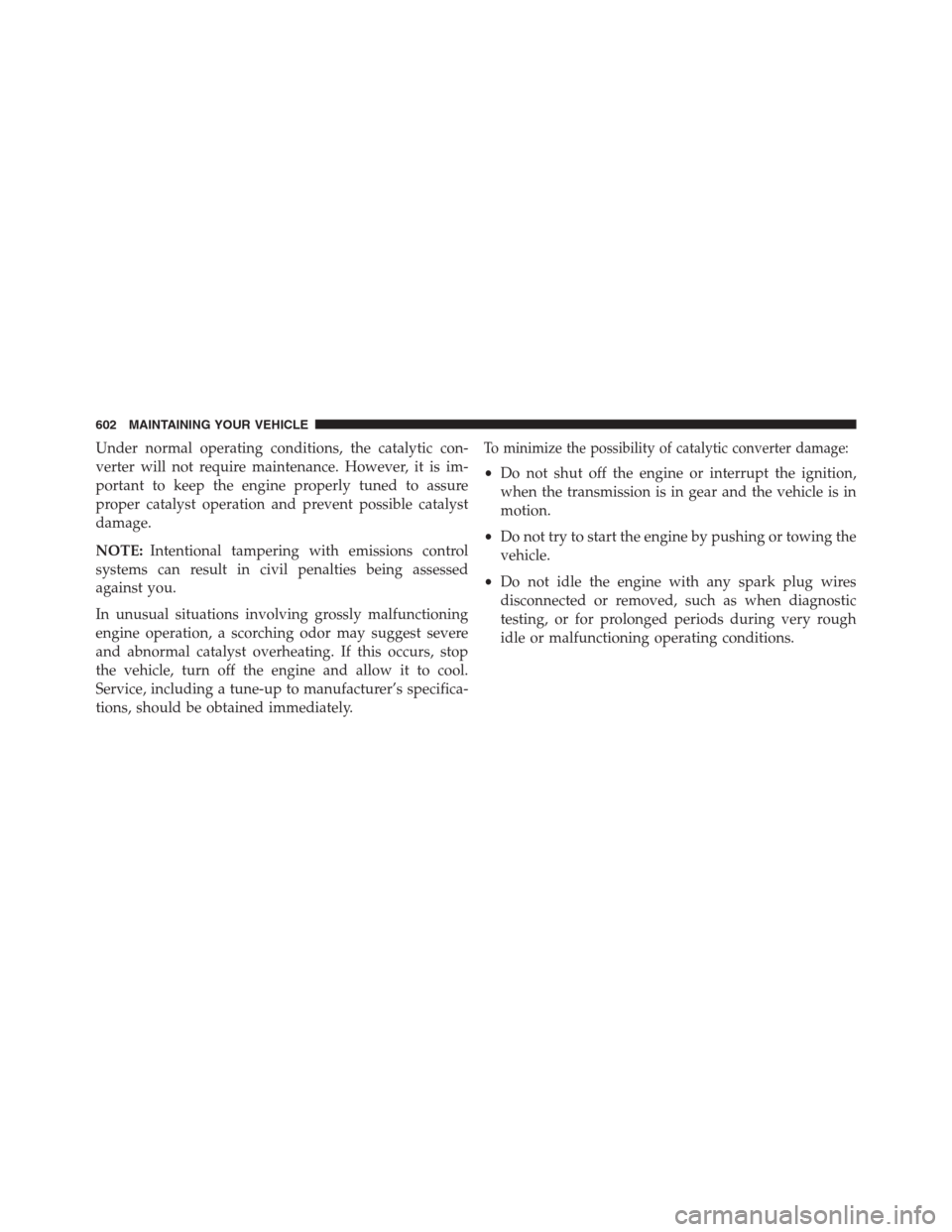Page 562 of 683

HAZARD WARNING FLASHERS
The Hazard Warning flasher switch is located in the
lower center area of the instrument panel.
Press the switch to turn on the Hazard Warning
flasher. When the switch is activated, all direc-
tional turn signals will flash on and off to warn oncoming
traffic of an emergency. Press the switch a second time to
turn off the Hazard Warning flashers.
This is an emergency warning system and it should not
be used when the vehicle is in motion. Use it when your
vehicle is disabled and it is creating a safety hazard for
other motorists.
When you must leave the vehicle to seek assistance, the
Hazard Warning flashers will continue to operate even
though the ignition is placed in the OFF position.
NOTE:With extended use the Hazard Warning flashers
may wear down your battery.
IF YOUR ENGINE OVERHEATS
In any of the following situations, you can reduce the
potential for overheating by taking the appropriate action.
•On the highways — slow down.
•In city traffic — while stopped, place the transmission
in NEUTRAL, but do not increase engine idle speed.
NOTE:There are steps that you can take to slow down
an impending overheat condition:
•If your air conditioner (A/C) is on, turn it off. The A/C
system adds heat to the engine cooling system and
turning the A/C off can help remove this heat.
•
You can also turn the temperature control to maximum
heat, the mode control to floor and the blower control to
high. This allows the heater core to act as a supplement to
the radiator and aids in removing heat from the engine
cooling system.
560 WHAT TO DO IN EMERGENCIES
Page 585 of 683

8. Disconnect the opposite end of the positive(+)jumper
cable from the positive(+)post of the booster battery.
9. Disconnect the positive(+)end of the jumper cable
from the positive(+)post of the discharged vehicle.
If frequent jump-starting is required to start your vehicle
you should have the battery and charging system in-
spected at your authorized dealer.
CAUTION!
Accessories plugged into the vehicle power outlets
draw power from the vehicle’s battery, even when not
in use (i.e., cellular phones, etc.). Eventually, if
plugged in long enough without engine operation,
the vehicle’s battery will discharge sufficiently to
degrade battery life and/or prevent the engine from
starting.
FREEING A STUCK VEHICLE
If your vehicle becomes stuck in mud, sand or snow, it
can often be moved using a rocking motion. Turn the
steering wheel right and left to clear the area around the
front wheels. Then shift back and forth between DRIVE
and REVERSE while gently pressing the accelerator. Use
the least amount of accelerator pedal pressure that will
maintain the rocking motion, without spinning the
wheels or racing the engine.
CAUTION!
Racing the engine or spinning the wheels may lead to
transmission overheating and failure. Allow the en-
gine to idle with the transmission in NEUTRAL for at
least one minute after every five rocking-motion
cycles. This will minimize overheating and reduce
the risk of transmission failure during prolonged
efforts to free a stuck vehicle.
6
WHAT TO DO IN EMERGENCIES 583
Page 586 of 683

NOTE:Press the�ESC Off�switch, to place the Electronic
Stability Control (ESC) system in�Partial Off�mode
before rocking the vehicle. Refer to “Electronic Brake
Control System” in “Starting and Operating” for further
information.Once the vehicle has been freed, press the
�ESC Off�switch again to restore�ESC On�mode.
CAUTION!
•When “rocking” a stuck vehicle by shifting be-
tween DRIVE and REVERSE, do not spin the
wheels faster than 15 mph (24 km/h), or drivetrain
damage may result.
•Revving the engine or spinning the wheels too fast
may lead to transmission overheating and failure.
It can also damage the tires. Do not spin the wheels
above 30 mph (48 km/h) while in gear (no trans-
mission shifting occurring).Fast spinning tires can be dangerous. Forces generated by
excessive wheel speeds may cause damage, or even
failure, of the axle and tires. A tire could explode and
injure someone. Do not spin your vehicle’s wheels faster
than 30 mph (48 km/h) or for longer than 30 seconds
continuously without stopping when you are stuck and
do not let anyone near a spinning wheel, no matter what
the speed.
584 WHAT TO DO IN EMERGENCIES
Page 604 of 683

Under normal operating conditions, the catalytic con-
verter will not require maintenance. However, it is im-
portant to keep the engine properly tuned to assure
proper catalyst operation and prevent possible catalyst
damage.
NOTE:Intentional tampering with emissions control
systems can result in civil penalties being assessed
against you.
In unusual situations involving grossly malfunctioning
engine operation, a scorching odor may suggest severe
and abnormal catalyst overheating. If this occurs, stop
the vehicle, turn off the engine and allow it to cool.
Service, including a tune-up to manufacturer’s specifica-
tions, should be obtained immediately.To minimize the possibility of catalytic converter damage:
•Do not shut off the engine or interrupt the ignition,
when the transmission is in gear and the vehicle is in
motion.
•Do not try to start the engine by pushing or towing the
vehicle.
•Do not idle the engine with any spark plug wires
disconnected or removed, such as when diagnostic
testing, or for prolonged periods during very rough
idle or malfunctioning operating conditions.
602 MAINTAINING YOUR VEHICLE
Page 668 of 683

Electrical Power Outlets.....................269
Electric Remote Mirrors.....................133
Electronic Brake Control System...............486
Brake Assist System.....................487
Electronic Speed Control (Cruise Control)........237
Electronic Stability Control (ESC)..............488
Electronic Vehicle Information Center (EVIC)......325
Emergency, In Case of
Hazard Warning Flasher..................560
Jacking...............................561
Jump Starting..........................579
Overheating...........................560
Emission Control System Maintenance..........593
Engine
Air Cleaner...........................599
Block Heater..........................464
Break-In Recommendations................116
Checking Oil Level......................597
Compartment..........................591Compartment Identification................591
Coolant (Antifreeze).....................609
Cooling..............................608
Exhaust Gas Caution.....................117
Flooded, Starting.......................462
Fuel Requirements......................528
Oil..................................597
Oil Selection...........................597
Oil Synthetic..........................598
Overheating...........................560
Starting..............................461
Temperature Gauge......................322
Engine Oil Viscosity.......................598
Engine Oil Viscosity Chart...................598
Enhanced Accident Response Feature............85
Entry System, Illuminated....................20
Ethanol................................529
Event Data Recorder........................88
Exhaust Gas Caution........................55
666 INDEX
Page 675 of 683

Odometer...............................312
Oil Change Indicator.......................313
Oil Change Indicator, Reset..................313
Oil, Engine..............................597
Capacity.............................638
Change Interval........................597
Checking.............................597
Disposal..............................599
Filter................................599
Filter Disposal.........................599
Identification Logo......................598
Materials Added to......................599
Recommendation.......................597
Synthetic.............................598
Viscosity.............................598
Oil Filter, Selection........................599
Onboard Diagnostic System..................592
Opener, Garage Door (HomeLink®)............256
Operator Manual (Owner’s Manual).............4Outside Rearview Mirrors...................130
Overhead Console.........................252
Overhead Travel Information Center............252
Overheating, Engine.......................322
Owner’s Manual (Operator Manual).............4
Paint Care..............................619
Panic Alarm..............................25
Parking Brake............................481
Park Sense System, Rear....................241
Pedals, Adjustable.........................235
Personal Settings..........................342
Pets, Transporting.........................112
Placard, Tire and Loading Information..........502
Power
Door Locks............................37
Lift Gate..............................53
Mirrors..............................133
Outlet (Auxiliary Electrical Outlet)
...........26910
INDEX 673
Page:
< prev 1-8 9-16 17-24